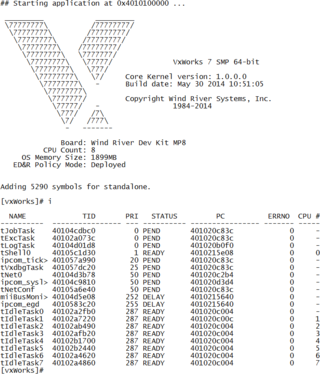Related Research Articles
The Portable Operating System Interface is a family of standards specified by the IEEE Computer Society for maintaining compatibility between operating systems. POSIX defines both the system and user-level application programming interfaces (APIs), along with command line shells and utility interfaces, for software compatibility (portability) with variants of Unix and other operating systems. POSIX is also a trademark of the IEEE. POSIX is intended to be used by both application and system developers.
A real-time operating system (RTOS) is an operating system (OS) for real-time computing applications that processes data and events that have critically defined time constraints. An RTOS is distinct from a time-sharing operating system, such as Unix, which manages the sharing of system resources with a scheduler, data buffers, or fixed task prioritization in multitasking or multiprogramming environments. All operations must verifiably complete within given time and resource constraints or else fail safe. Real-time operating systems are event-driven and preemptive, meaning the OS can monitor the relevant priority of competing tasks, and make changes to the task priority. Event-driven systems switch between tasks based on their priorities, while time-sharing systems switch the task based on clock interrupts.

QNX is a commercial Unix-like real-time operating system, aimed primarily at the embedded systems market.
pSOS is a real-time operating system (RTOS), created in about 1982 by Alfred Chao, and developed and marketed for the first part of its life by his company Software Components Group (SCG). In the 1980s, pSOS rapidly became the RTOS of choice for all embedded systems based on the Motorola 68000 series family architecture, because it was written in 68000 assembly language and was highly optimised from the start. It was also modularised, with early support for OS-aware debugging, plug-in device drivers, Internet protocol suite (TCP/IP) stacks, language libraries, and disk subsystems. Later came source code level debugging, multiprocessing support, and further computer networking extensions.

VxWorks is a real-time operating system developed as proprietary software by Wind River Systems, a subsidiary of Aptiv. First released in 1987, VxWorks is designed for use in embedded systems requiring real-time, deterministic performance and in many cases, safety and security certification for industries such as aerospace, defense, medical devices, industrial equipment, robotics, energy, transportation, network infrastructure, automotive, and consumer electronics.

An Embedded Operating System (EOS) is an operating system designed specifically for embedded computer systems. These systems aim to enhance functionality and reliability to perform dedicated tasks. When the multitasking method employed allows for timely task execution, such an OS may qualify as a real-time operating system (RTOS).
RTLinux is a hard realtime real-time operating system (RTOS) microkernel that runs the entire Linux operating system as a fully preemptive process. The hard real-time property makes it possible to control robots, data acquisition systems, manufacturing plants, and other time-sensitive instruments and machines from RTLinux applications. The design was patented. Despite the similar name, it is not related to the Real-Time Linux project of the Linux Foundation.
In computing, POSIX Threads, commonly known as pthreads, is an execution model that exists independently from a programming language, as well as a parallel execution model. It allows a program to control multiple different flows of work that overlap in time. Each flow of work is referred to as a thread, and creation and control over these flows is achieved by making calls to the POSIX Threads API. POSIX Threads is an API defined by the Institute of Electrical and Electronics Engineers (IEEE) standard POSIX.1c, Threads extensions .
Nucleus RTOS is a real-time operating system (RTOS) produced by the Embedded Software Division of Mentor Graphics, a Siemens Business, supporting 32- and 64-bit embedded system platforms. The operating system (OS) is designed for real-time embedded systems for medical, industrial, consumer, aerospace, and Internet of things (IoT) uses. Nucleus was released first in 1993. The latest version is 3.x, and includes features such as power management, process model, 64-bit support, safety certification, and support for heterogeneous computing multi-core system on a chip (SOCs) processors.

FreeRTOS is a real-time operating system kernel for embedded devices that has been ported to 40 microcontroller platforms. It is distributed under the MIT License.
Eclipse ThreadX is a highly deterministic, embedded real-time operating system (RTOS) programmed mostly in the language C.
TI-RTOS is an embedded tools ecosystem created and offered by Texas Instruments (TI) for use across a range of their embedded system processors. It includes a real-time operating system (RTOS) component-named TI-RTOS Kernel, networking connectivity stacks, power management, file systems, instrumentation, and inter-processor communications like DSP/BIOS Link. It is free and open-source software, released under a BSD license.
IntervalZero, Inc. develops hard real-time software and its symmetric multiprocessing (SMP) enabled RTX and RTX64 software transform the Microsoft Windows general-purpose operating system (GPOS) into a real-time operating system (RTOS).

QP is a family of open source real-time embedded frameworks (RTEFs) and runtime environments based on active objects (actors) and hierarchical state machines. The QP family consists of the lightweight QP/C and QP/C++ frameworks, written in C (C99) and C++ (C++11), respectively.
NuttX is a free and open-source real-time operating system (RTOS) with an emphasis on technical standards compliance and on having a small footprint. Scalable from 8-bit to 64-bit microcontroller environments, the main governing standards in NuttX are from the Portable Operating System Interface (POSIX) and the American National Standards Institute (ANSI). Further standard application programming interfaces (APIs) from Unix and other common RTOSes are adopted for functions unavailable under these standards, or inappropriate for deeply embedded environments, such as the fork system call.

RTX / RTX64 are real-time operating system (RTOS) by the firm IntervalZero. They are software extensions that convert Microsoft Windows operating system into a RTOS. It was the first Windows real-time solution on the market.

Zephyr is a small real-time operating system (RTOS) for connected, resource-constrained and embedded devices supporting multiple architectures and released under the Apache License 2.0. Zephyr includes a kernel, and all components and libraries, device drivers, protocol stacks, file systems, and firmware updates, needed to develop full application software.
PX5 RTOS is a real-time operating system (RTOS) designed for embedded systems. It is implemented using the ANSI C programming language.
References
- ↑ Cole, Bernard; McConnel, Toni (3 September 2010). "Bill Lamie: Story of a man and his real-time operating systems". Embedded.com. Retrieved 18 September 2023.
- ↑ Nass, Rich (1 February 2023). "Embedded Executive: Bill Lamie, President and CEO, PX5". Embedded Computing Design. Retrieved 18 September 2023.
- ↑ Nass, Rich (15 April 2015). "Five Minutes With...Bill Lamie, CEO/Co-Founder, Express Logic". Embedded Computing Design. Retrieved 18 September 2023.
- ↑ Flaherty, Nick (26 March 2023). "Nucleus RTOS hits 30, boosts safety certifications". eeNews Europe. Retrieved 21 September 2023.
- ↑ Wiggers, Kyle (18 April 2019). "Microsoft acquires Express Logic for its real-time internet of things operating system". VentureBeat . Retrieved 21 September 2023.
- ↑ MSV, Janakiram (21 April 2019). "How Does The Express Logic Acquisition Help Microsoft And The IoT Ecosystem". Forbes . Retrieved 21 September 2023.
- ↑ Tuip, Martin (9 June 2021). "Building IoT solutions with RTOS". Microsoft Tech Community . Retrieved 21 September 2023.
- ↑ "PX5 RTOS Simplifies Development of 64-bit Hard Real-Time Applications with Support for IAR Embedded Workbench for Arm". Yahoo! Finance . San Diego. 12 June 2023. Retrieved 22 August 2023.
- ↑ Jagdale, Saumitra (27 February 2023). "PX5: a new RTOS for real-time multithread scheduling in under 1KB". Embedded.com. Retrieved 29 August 2023.
- ↑ Maxfield, Max (9 February 2023). "New PX5 RTOS Boasts Native Support for POSIX pthreads API". Electronic Engineering Journal. Retrieved 25 August 2023.
- ↑ "IAR Systems Fully Supports the Brand-new Industrial-Grade PX5 RTOS". Automation.com. 26 January 2023. Retrieved 29 August 2023.
- ↑ "Reducing safety and security risks for embedded systems". MMG Publishing. Retrieved 29 August 2023.
- ↑ "IAR Systems implements PX5 RTOS for its IAR Embedded Workbench". IoT Now. 17 June 2023. Retrieved 29 August 2023.
- ↑ Bush, Steve (26 January 2023). "IAR Systems adds support for PX5 industrial-grade RTOS". Electronics Weekly . Retrieved 29 August 2023.